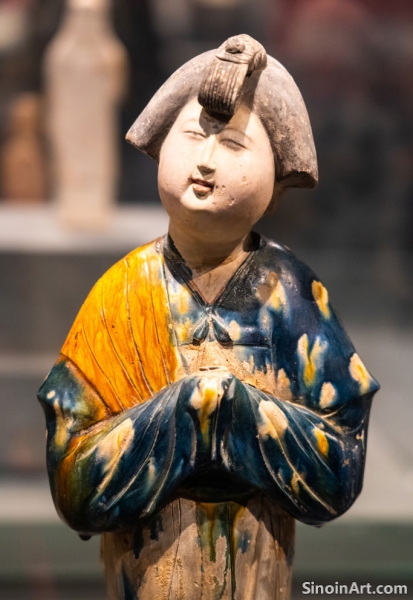The Dawn of Celadon Splendor
|
The Tang Dynasty (618-907 AD) represents a crucial period in the history of Chinese ceramics, particularly in the development and refinement of celadon wares. While not as dramatically innovative as the later Song dynasty, the Tang era saw a significant leap in kiln technology, material preparation, and artistic understanding that laid the groundwork for future ceramic masterpieces. Celadon, with its subtle green hues reminiscent of jade, enjoyed immense popularity, favored by both the imperial court and the burgeoning merchant class. Tang celadon wasn't just about mimicking jade; it was about capturing the essence of natural beauty and the philosophical ideals of the time.  The distinguishing feature of Tang celadon was the improvement in glaze composition. By experimenting with different clay and iron oxide ratios, potters achieved a richer, more consistent green glaze than their predecessors. The glaze was typically thick and had a glossy, almost jade-like texture. The forms were diverse, ranging from simple bowls and dishes to more elaborate ewers and vases. The earlier Tang celadons, influenced by the preceding dynasties, often featured simpler, more robust forms. Over time, however, a greater sense of elegance and sophistication became apparent in the shapes and decorative elements.  Decoration on Tang celadon was generally restrained, emphasizing the beauty of the glaze itself. Incised or carved designs, often depicting floral motifs or simple geometric patterns, were employed to add subtle textural depth. Unlike the later Song dynasty, where meticulous craftsmanship and minimal surface decoration became the hallmark of celadon, Tang potters were still exploring the balance between form and ornamentation. This experimentation led to a wide variety of styles and techniques, contributing to the rich tapestry of Tang ceramic art.  The importance of Tang celadon extended beyond its aesthetic appeal. It served as a valuable commodity for trade along the Silk Road, carrying the artistry of Tang China to distant lands. Fragments of Tang celadon have been unearthed in various parts of Asia and even the Middle East, testifying to its widespread popularity and influence. This global distribution of Tang ceramics not only highlights their value as trade goods but also speaks to the sophisticated tastes of the era. The legacy of Tang Dynasty celadon continues to inspire contemporary ceramic artists. Its harmonious balance of form, glaze, and subtle decoration serves as a timeless example of ceramic artistry at its finest. The developments during the Tang era paved the way for the golden age of Chinese porcelain in subsequent dynasties, demonstrating the fundamental importance of this period in the long and celebrated history of Chinese ceramics. |
Tag : Tang Dynasty celadon, Chinese celadon, green glaze porcelain, ancient Chinese ceramics, Silk Road pottery
Related information
- The Evolution of Tang Porcelain Forms
- The Influence of Foreign Cultures on Tang Ceramics
- Sancai Ware: A Symphony of Three Colors
- Collecting and Appreciating Tang Ceramics Today
- The Enduring Legacy of Tang Dynasty Ceramics
The forms and shapes of Tang Dynasty ceramics were as diverse and dynamic as the society that produced them. From simple utilitarian bowls to elaborate ceremonial vessels, the ceramic forms reflected the varied functions and aesthetic preferences of the time. The evolution of Tang ceramic forms was also driven by technical innovations and artistic experimentation, resulting in a wide range of shapes and sizes that showcase the ingenuity of Tang potters.
The Tang Dynasty’s openness to international exchange significantly influenced its ceramics, evident in the adoption of foreign patterns, vessel forms, and decorative techniques, reflecting the cosmopolitan spirit of the era.
Sancai, meaning “three-color” in Chinese, is perhaps the most iconic ceramic ware of the Tang Dynasty. These vibrant and richly glazed pieces are instantly recognizable for their combination of green, amber, and cream or straw-yellow glazes. While the term suggests a limited palette, the actual range of colors could vary, sometimes incorporating blues and purples, creating a dazzling visual spectacle. Sancai ware wasn’t just about color; it was a bold statement of Tang aesthetics and technical prowess.
Tang Dynasty ceramics are highly valued by collectors and museums for their historical significance, artistic beauty, and technical innovation, requiring a detailed understanding for informed collecting and appreciation of these important cultural artifacts.
The ceramic art of the Tang Dynasty represents a peak in Chinese ceramic history, leaving an enduring legacy that continues to inspire artists, collectors, and scholars today. The innovative techniques, vibrant colors, and elegant forms of Tang wares established a new standard for ceramic production, influencing subsequent generations of potters both in China and around the world.